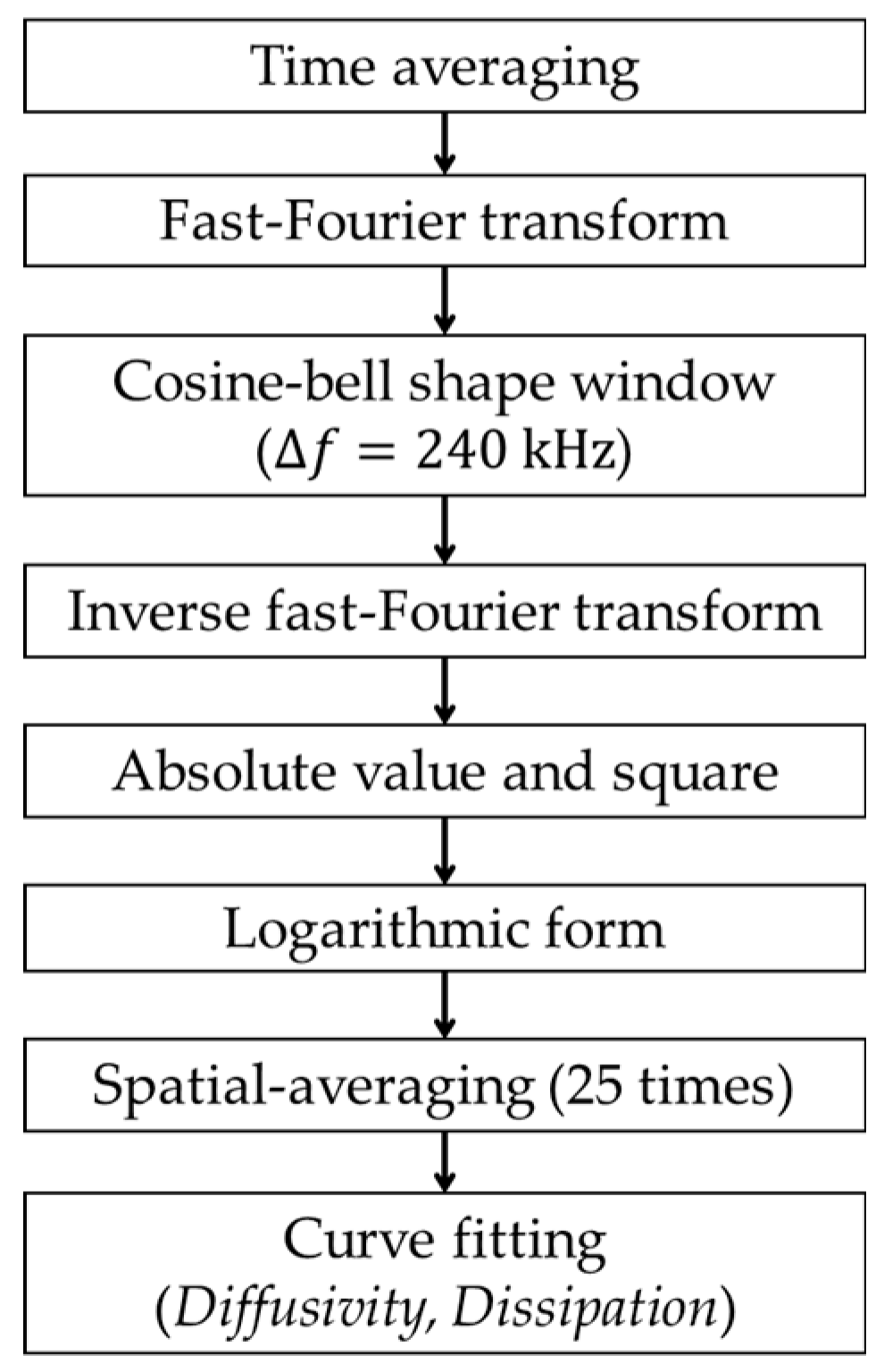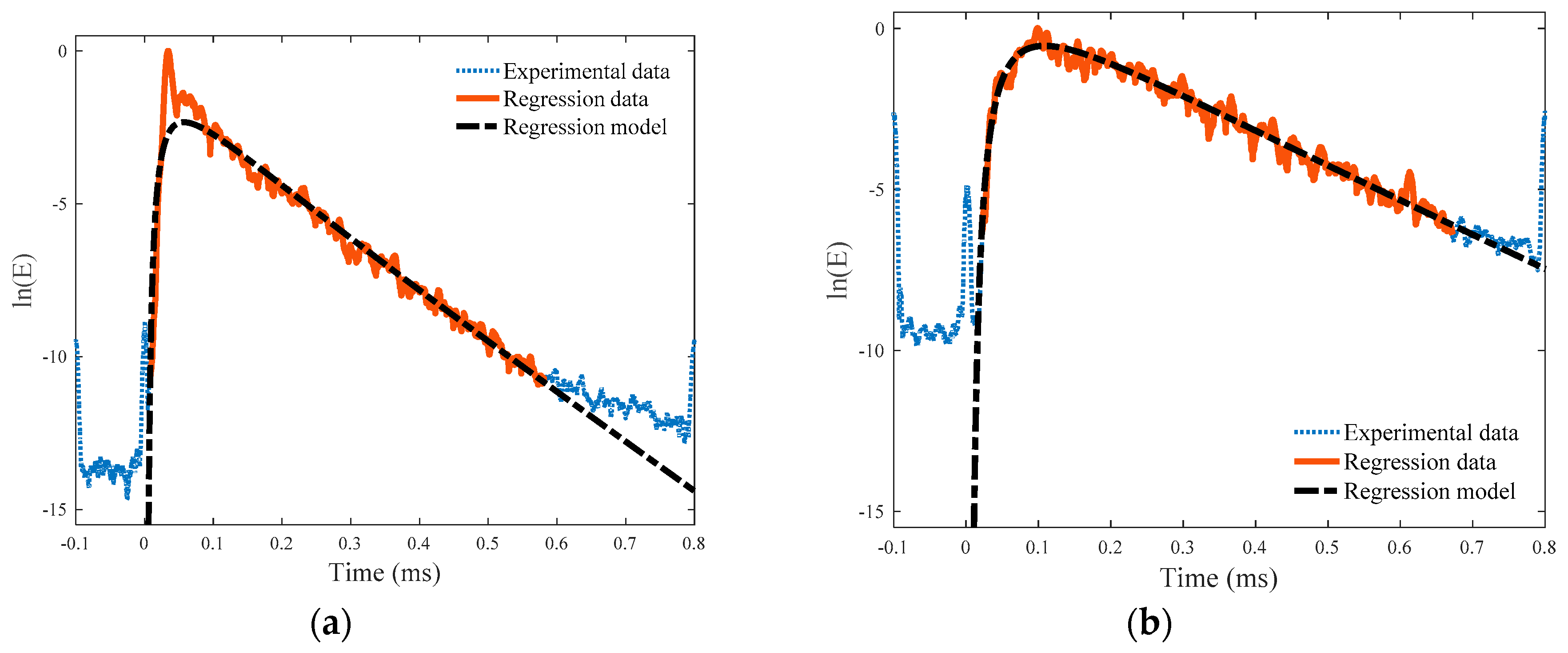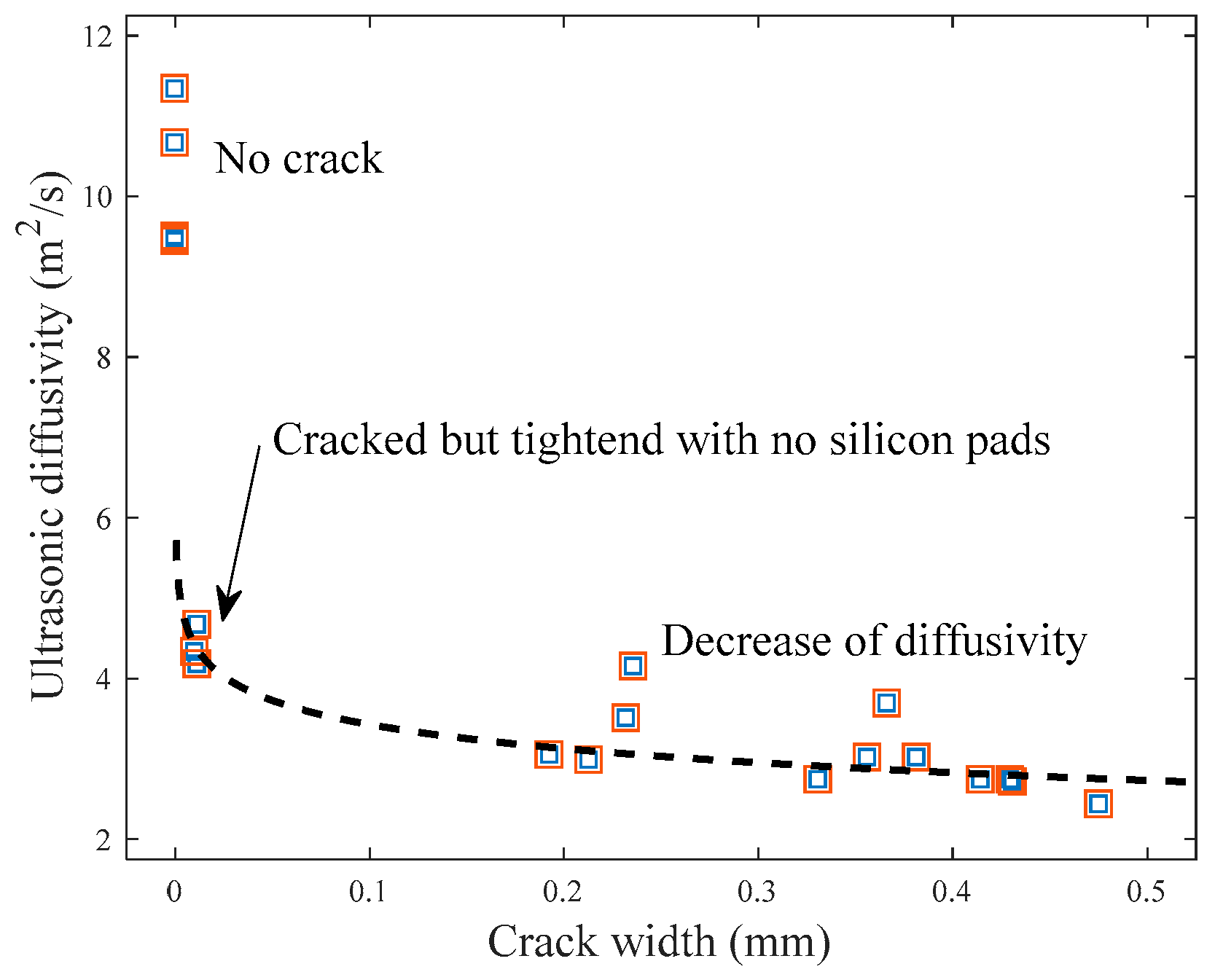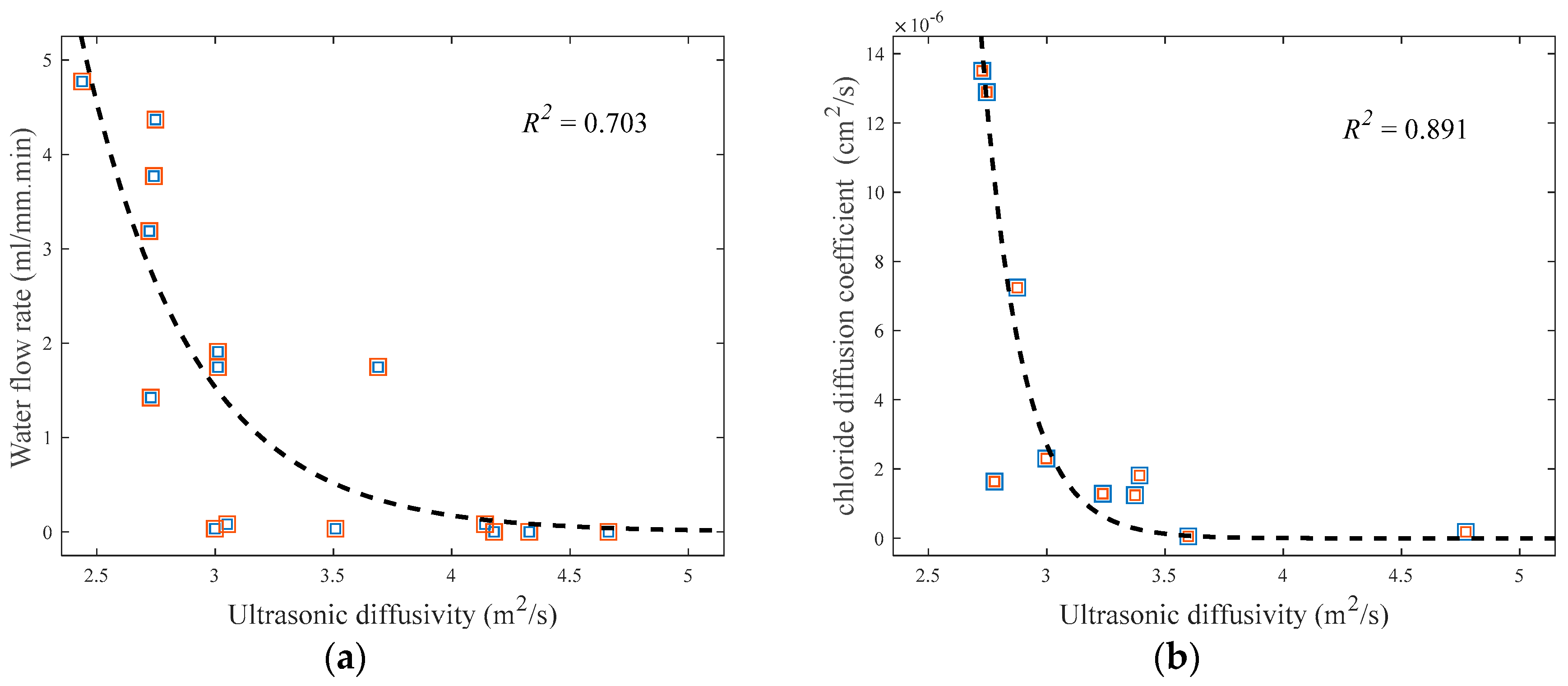Applicability of Diffuse Ultrasound to Evaluation of the Water Permeability and Chloride Ion Penetrability of Cracked Concrete
Abstract
1. Introduction
2. Theoretical Background of Diffuse Ultrasound
3. Test Specimens
3.1. Preparation of Specimens
3.2. Determination of Average Crack Width
4. Test Methods
4.1. Diffuse Ultrasound Test
4.1.1. Test Configuration
4.1.2. Data Processing
4.2. Water Permeability Test
4.3. Chloride Ion Penetration Test
5. Experimental Results and Discussion
5.1. Effect of Crack Width on Water Permeability
5.2. Effect of Crack Width on Chloride Ion Penetrability
5.3. Effect of Crack Width on Diffuse Ultrasound Parameters
5.4. Correlation between Ultrasonic Diffusivity and Durability Indices
5.5. Discussion
- (1)
- Presence of coarse aggregate: Mortars with no coarse aggregate were used for both diffuse ultrasound and durability tests to first tackle the more fundamental case, achieving the critical goal of generating a uniform crack width along the length and depth of the crack. Typical concrete contains coarse aggregate of approximately 20 to 25 mm. With the presence of randomly distributed coarse aggregate particles, the crack configuration will be more irregular and uneven, as well as the diffuse wave test results will be affected by different scattering phenomena from the increase of heterogeneity. The effects of coarse aggregate (e.g., size, ratio) should be investigated for practical applications of diffuse ultrasound in concrete structures.
- (2)
- Crack generation method: This study used the tensile splitting and assembling method in fabricating the crack in each specimen. On the other hand, the use of a crack mouth opening displacement measurement device would be more effective to avoid the interlocking issue between paired crack faces. However, a more important issue of this study was to ensure the fabrication of a uniform crack width along the entire length of the crack. Without complete splitting, the crack width typically varies along the length of the crack, which is wider near the center and narrower close to the end. After complete splitting, we used a microscope to minimize the misalignment of crack faces. Accordingly, a more efficient crack generation method should be pursued to not only precisely simulate the actual conditions of real cracks but also resolve the interlocking issue.
- (3)
- Test configuration: The test configuration (e.g., specimen size, crack shape and dimensions) used in the current study may not be appropriate to represent some of real structures. Many different conditions of cracks may occur in concrete structures under various loads, and no single test configuration can fit to all the different situations. This study focused on slab- or wall-like members having a penetrating crack with a relatively uniform width through the member thickness. The test setups used for diffuse ultrasound, water permeability, and chloride penetrability were considered effective for the aforesaid type of cracks even in real structures. Future studies will be needed for other conditions of cracks (e.g., partially closed cracks, those due to bending, multiple cracks) and suitable test configurations.
- (4)
- Specimen dimensions and boundary conditions: An identical size of small specimens were used to conduct both diffuse ultrasound tests and durability tests. High-frequency diffuse ultrasound (e.g., over 200 kHz) tends to quickly spend energy within a relatively small spatial domain. Thus, to apply diffuse ultrasound to the evaluation of voluminous concrete members, a high-energy high-frequency wave generator will be needed. In addition, the diffusion equation for 2-dimensional infinite media was used for evaluating the ultrasonic diffusivity and dissipation without considering the reflections of diffuse wave signals from all boundaries. This approach is useful to investigate qualitative trends of ultrasonic diffusion parameters influenced by the test variables, but may have a limitation in assessing quantitative conditions of real structures with various boundary conditions. Future research is desired to examine the effects of boundary conditions on the diffusion characteristics of ultrasound and the method of taking into account such effects.
- (5)
- Complex material compositions: The diffusion characteristics of a certain frequency range of ultrasound greatly depend on the properties of material compositions in concrete. For instance, the frequency range of ultrasound should be carefully selected considering the dimensions of heterogeneities (e.g., cracks, aggregate particles, pores) to ensure sufficient scattering of the waves. Further studies should be performed to comprehend the effects of material compositions on the behavior of diffuse ultrasound.
6. Conclusions
- (1)
- The measured water flow rate in the cracked specimens, defined as the amount of water passing through the crack per minute divided by the length of the crack, was well estimated by a cubic polynomial function of average crack width, which agrees with Hagen–Poiseuille’s law. Similarly, the measured chloride diffusion coefficient was best represented by a cubic function of average crack width.
- (2)
- Both the ultrasonic diffusivity and dissipation in the concrete specimens were significantly affected by the frequencies of chosen wave components. The frequency ranges from 200 to 440 kHz was considered to determine the diffuse ultrasound parameters, based on the variation and reliability of signals.
- (3)
- The diffusion of ultrasound considerably diminished in the presence of the penetrating crack, compared with the crack-free specimens. The diffusivity coefficient generally decreased in accordance with increasing average crack width, although the change of diffusivity was not significant because of the cracks completely penetrating through the specimens.
- (4)
- Both the water flow rate and chloride diffusion coefficient decreased as the ultrasonic diffusivity increased. The two durability indices rapidly reduced at about 2.5–3.5 m2/s of the diffusivity coefficient of ultrasound, which corresponds to the average crack width of approximately 0.3 mm.
- (5)
- The test results suggest that diffuse ultrasound is a promising method for the evaluation of the water permeability and chloride ion penetrability of cracked concrete. For its practical use in real structures, however, future research is needed to overcome the limitations of the proposed methodology and improve the accuracy.
Author Contributions
Funding
Acknowledgments
Conflicts of Interest
References
- Mehta, P.K.; Monteiro, P.J.M.; Ebrary, I. Concrete: Microstructure, Properties, and Materials, 3rd ed.; McGraw Hill: New York, NY, USA, 2006. [Google Scholar]
- Ahmad, S. Reinforcement corrosion in concrete structures, its monitoring and service life prediction—A review. Cem. Concr. Compos. 2003, 25, 459–471. [Google Scholar] [CrossRef]
- Kwon, S.J.; Na, U.J.; Park, S.S.; Jung, S.H. Service life prediction of concrete wharves with early-aged crack: Probabilistic approach for chloride diffusion. Struct. Saf. 2009, 31, 75–83. [Google Scholar] [CrossRef]
- ACI 228.2R-13. Report on Nondestructive Test Methods for Evaluation of Concrete in Structures; American Concrete Institute: Farmington Hills, MI, USA, 2013. [Google Scholar]
- Popovics, J.S.; Rose, J.L. A survey of developments in ultrasonic NDE of concrete. IEEE Trans. Ultrason. Ferroelectr. Freq. Control 1994, 41, 140–143. [Google Scholar] [CrossRef]
- Planès, T.; Larose, E. A review of ultrasonic Coda Wave Interferometry in concrete. Cem. Concr. Res. 2013, 53, 248–255. [Google Scholar] [CrossRef]
- Popovics, J.S.; Song, W.; Achenbach, J.D.; Lee, J.H.; Andre, R.F. One-sided stress wave velocity measurement in concrete. J. Eng. Mech. 1998, 124, 1346–1353. [Google Scholar] [CrossRef]
- Shin, S.W.; Zhu, J.; Min, J.; Popovics, J.S. Crack depth estimation in concrete using energy transmission of surface waves. ACI Mater. J. 2008, 105, 510–516. [Google Scholar]
- Ahn, E.; Kim, H.; Sim, S.-H.; Shin, S.W.; Popovics, J.S.; Shin, M. Surface-wave based model for estimation of discontinuity depth in concrete. Sensors 2018, 18, 2793. [Google Scholar] [CrossRef] [PubMed]
- Ramamoorthy, S.K.; Kane, Y.; Turner, J.A. Ultrasound diffusion for crack depth determination in concrete. J. Acoust. Soc. Am. 2004, 115, 523–529. [Google Scholar] [CrossRef] [PubMed]
- In, C.W.; Holland, R.B.; Kim, J.Y.; Kurtis, K.E.; Kahn, L.F.; Jacobs, L.J. Monitoring and evaluation of self-healing in concrete using diffuse ultrasound. NDT E Int. 2013, 57, 36–44. [Google Scholar] [CrossRef]
- Quiviger, A.; Payan, C.; Chaix, J.F.; Garnier, V.; Salin, J. Effect of the presence and size of a real macro-crack on diffuse ultrasound in concrete. NDT E Int. 2012, 45, 128–132. [Google Scholar] [CrossRef]
- Payan, C.; Quiviger, A.; Garnier, V.; Chaix, J.F.; Salin, J. Applying diffuse ultrasound under dynamic loading to improve closed crack characterization in concrete. J. Acoust. Soc. Am. 2013, 134, EL211–EL216. [Google Scholar] [CrossRef] [PubMed]
- Seher, M.; In, C.W.; Kim, J.Y.; Kurtis, K.E.; Jacobs, L.J. Numerical and experimental study of crack depth measurement in concrete using diffuse ultrasound. J. Nondestr. Eval. 2013, 32, 81–92. [Google Scholar] [CrossRef]
- In, C.W.; Arne, K.; Kim, J.Y.; Kurtis, K.E.; Jacobs, L.J. Estimation of crack depth in concrete using diffuse ultrasound: Validation in cracked concrete beams. J. Nondestr. Eval. 2017, 36, 4. [Google Scholar] [CrossRef]
- Hilloulin, B.; Legland, B.J.B.; Lys, E.; Abraham, O.; Loukili, A.; Grondin, F.; Tournat, O.D.V. Monitoring of autogenous crack healing in cementitious materials by the nonlinear modulation of ultrasonic coda waves, 3D microscopy and X-ray microtomography. Constr. Build. Mater. 2016, 123, 143–152. [Google Scholar] [CrossRef]
- Liu, S.; Bundur, Z.B.; Zhu, J.; Ferron, R.D. Evaluation of self-healing of internal cracks in biomimetic mortar using coda wave interferometry. Cem. Concr. Res. 2016, 83, 70–78. [Google Scholar] [CrossRef]
- Hilloulin, B.; Zhang, Y.; Abraham, O.; Loukili, A.; Grondin, F.; Durand, O.; Tournat, V. Small crack detection in cementitious materials using nonlinear coda wave modulation. NDT E Int. 2014, 68, 98–104. [Google Scholar] [CrossRef]
- Song, H.; Popovics, J.S. Characterization of steel-concrete interface bonding conditions using attenuation characteristics of guided waves. Cem. Concr. Compos. 2017, 83, 111–124. [Google Scholar] [CrossRef]
- Kim, G.; In, C.W.; Kim, J.Y.; Kurtis, K.E.; Jacobs, L.J. Air-coupled detection of nonlinear Rayleigh surface waves in concrete—Application to microcracking detection. NDT E Int. 2014, 67, 64–70. [Google Scholar] [CrossRef]
- Ahn, E.; Kim, H.; Sim, S.-H.; Shin, S.W.; Shin, M. Principles and applications of ultrasonic-based nondestructive methods for self-healing in cementitious materials. Materials 2017, 10, 278. [Google Scholar] [CrossRef] [PubMed]
- Becker, J.; Jacobs, L.J.; Qu, J. Characterization of cement-based materials using diffuse ultrasound. J. Eng. Mech. 2003, 129, 1478–1484. [Google Scholar] [CrossRef]
- Punurai, W.; Jarzynski, J.; Qu, J.; Kurtis, J.K.E.; Jacobs, L.J. Characterization of dissipation losses in cement paste with diffuse ultrasound. Mech. Res. Commun. 2007, 34, 289–294. [Google Scholar] [CrossRef]
- Deroo, F.; Kim, J.Y.; Qu, J.; Sabra, K.; Jacobs, L.J. Detection of damage in concrete using diffuse ultrasound. J. Acoust. Soc. Am. 2010, 127, 3315–3318. [Google Scholar] [CrossRef] [PubMed]
- Yim, H.J.; An, Y.; Kim, J.H. Water depercolation of setting cement paste evaluated by diffuse ultrasound. Cem. Concr. Compos. 2016, 71, 10–19. [Google Scholar] [CrossRef]
- Figg, J.W. Methods of measuring the air and water permeability of concrete. Mag. Concr. Res. 1973, 25, 213–219. [Google Scholar] [CrossRef]
- Claisse, P.A.; Ganjian, E.; Adham, T.A. In situ measurement of the intrinsic permeability of concrete. Mag. Concr. Res. 2003, 55, 125–132. [Google Scholar] [CrossRef]
- Aldea, C.M.; Shah, S.P.; Karr, A. Effect of cracking on water and chloride permeability of concrete. J. Mater. Civ. Eng. 1999, 11, 181–187. [Google Scholar] [CrossRef]
- Aldea, C.M.; Song, W.J.; Popovics, J.S.; Shah, S.P. Extent of healing of cracked normal strength concrete. J. Mater. Civ. Eng. 2000, 12, 92–96. [Google Scholar] [CrossRef]
- Shin, K.J.; Bae, W.; Choi, S.W.; Son, M.W.; Lee, K.M. Parameters influencing water permeability coefficient of cracked concrete specimens. Constr. Build. Mater. 2017, 151, 907–915. [Google Scholar] [CrossRef]
- Jacobsen, S.; Marchand, J.; Boisvert, L. Effect of cracking and healing on chloride transport in OPC concrete. Cem. Concr. Res. 1996, 26, 869–881. [Google Scholar] [CrossRef]
- Oh, B.H.; Jang, S.Y. Prediction of diffusivity of concrete based on simple analytic equations. Cem. Concr. Res. 2004, 34, 463–480. [Google Scholar] [CrossRef]
- Park, S.S.; Kwon, S.J.; Jung, S.H. Analysis technique for chloride penetration in cracked concrete using equivalent diffusion and permeation. Constr. Build. Mater. 2012, 29, 183–192. [Google Scholar] [CrossRef]
- Jang, S.Y.; Kim, S.B.; Oh, B.H. Effect of crack width on chloride diffusion coefficients of concrete by steady-state migration tests. Cem. Concr. Res. 2011, 41, 9–19. [Google Scholar] [CrossRef]
- Kim, K.; Shin, M.; Cha, S. Combined effects of recycled aggregate and fly ash towards concrete sustainability. Constr. Build. Mater. 2013, 48, 499–507. [Google Scholar] [CrossRef]
- NT BUILD 355. Concrete, Mortar and Cement-based Repair Materials: Chloride Diffusion Coefficient from Migration Cell Experiments; Nordtest: Espoo, Finland, 1997. [Google Scholar]
- NT BUILD 492. Concrete, Mortar and Cement-based Repair Materials: Chloride Migration Coefficient from Non-Steady-State Migration Experiments; Nordtest: Espoo, Finland, 1999. [Google Scholar]
- ASTM C 1202-05. Standard Test Method for Electrical Indication of Concrete’s Ability to Resist Chloride Ion Penetration; American Society for Testing and Materials: West Conshohocken, PA, USA, 2006. [Google Scholar]
- Anugonda, P.; Wiehn, J.S.; Turner, J.A. Diffusion of ultrasound in concrete. Ultrasonics 2001, 39, 429–435. [Google Scholar] [CrossRef]
- Weaver, R.L. Ultrasonics in an aluminum foam. Ultrasonics 1998, 36, 435–442. [Google Scholar] [CrossRef]
- Kim, H.; Ahn, E.; Shin, M.; Cho, S.; Sim, S.-H. Comparative analysis of image binarization methods for crack identification in concrete structures. Cem. Concr. Res. 2017, 99, 53–61. [Google Scholar] [CrossRef]
- Kim, H.; Lee, J.; Ahn, E.; Cho, S.; Shin, M.; Sim, S.-H. Concrete crack identification using UAV incorporating hybrid image processing. Sensors 2017, 17, 2052. [Google Scholar] [CrossRef] [PubMed]
- Sauvola, J.; Pietikäinen, M. Adaptive document image binarization. Pattern Recognit. 2000, 32, 225–236. [Google Scholar] [CrossRef]
- Das, B.M. Advanced Soil Mechanics, 3rd ed.; CRC Press: Boca Raton, FL, USA, 2013. [Google Scholar]
- Fox, R.W.; McDonald, A.T.; Pritchard, P.J. Introduction to Fluid Mechanics, 8th ed.; John Wiley & Sons: New York, NY, USA, 2011. [Google Scholar]












| Wave Frequency (kHz) | Diffusivity Coefficient (m2/s) | Dissipation Coefficient (1/ms) | ||||
|---|---|---|---|---|---|---|
| Average | Standard Deviation | COV | Average | Standard Deviation | COV | |
| 200 | 14.7 | 4.35 | 29.6% | 8.60 | 1.64 | 19.0% |
| 250 | 13.9 | 2.35 | 16.9% | 11.2 | 2.44 | 21.7% |
| 300 | 13.0 | 1.16 | 8.90% | 13.5 | 3.02 | 22.4% |
| 350 | 10.1 | 1.03 | 10.2% | 17.1 | 3.72 | 21.8% |
| 400 | 7.50 | 0.69 | 9.20% | 19.9 | 4.74 | 23.8% |
| 450 | 5.69 | 0.81 | 14.2% | 25.1 | 6.24 | 24.8% |
© 2018 by the authors. Licensee MDPI, Basel, Switzerland. This article is an open access article distributed under the terms and conditions of the Creative Commons Attribution (CC BY) license (http://creativecommons.org/licenses/by/4.0/).
Share and Cite
Ahn, E.; Gwon, S.; Kim, H.; Kim, C.; Sim, S.-H.; Shin, M. Applicability of Diffuse Ultrasound to Evaluation of the Water Permeability and Chloride Ion Penetrability of Cracked Concrete. Sensors 2018, 18, 4156. https://doi.org/10.3390/s18124156
Ahn E, Gwon S, Kim H, Kim C, Sim S-H, Shin M. Applicability of Diffuse Ultrasound to Evaluation of the Water Permeability and Chloride Ion Penetrability of Cracked Concrete. Sensors. 2018; 18(12):4156. https://doi.org/10.3390/s18124156
Chicago/Turabian StyleAhn, Eunjong, Seongwoo Gwon, Hyunjun Kim, Chanyoung Kim, Sung-Han Sim, and Myoungsu Shin. 2018. "Applicability of Diffuse Ultrasound to Evaluation of the Water Permeability and Chloride Ion Penetrability of Cracked Concrete" Sensors 18, no. 12: 4156. https://doi.org/10.3390/s18124156
APA StyleAhn, E., Gwon, S., Kim, H., Kim, C., Sim, S.-H., & Shin, M. (2018). Applicability of Diffuse Ultrasound to Evaluation of the Water Permeability and Chloride Ion Penetrability of Cracked Concrete. Sensors, 18(12), 4156. https://doi.org/10.3390/s18124156






